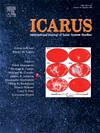Comparison of meteor shower observed by two collocated meteor radars at low latitudes
IF 2.5
2区 物理与天体物理
Q2 ASTRONOMY & ASTROPHYSICS
引用次数: 0
Abstract
We present results in which we compare simultaneous meteor shower observations using two meteor radars located in Kunming, China (25.6°N, 103.8°E). These are the 37.5 MHz ‘all-sky’ Kunming meteor radar (KMMR) and the 53.1 MHz Kunming Stratospheric–Tropospheric ST/Meteor radar (KMST). We first explore the Southern Delta Aquariids (SDA) meteor shower, one of the most active annual sources in the southern hemisphere, as an example, and one with ambiguous radiant. From this, we propose a new approach to determine the azimuthal angular deviation from true north for the radars and find a result of 14.7° on the KMMR and less than 1° for the KMST. These results are used to correct the receiving antenna baseline of the meteor radars. After correcting for this in the Horizontal Coordinate System of the KMMR, we find more than 2000 shower meteors originating from the radiant of Right Ascension (R.A.) =339.8° ± 2.7°, and declination (Dec.) = −16.9° ± 1.7° (J2000), and more than 1300 shower meteors from a region of R.A. = 339° ± 2.9°, Dec. = −16° ± 1.8° (J2000) from the KMST. A consistent finding between the radars was that SDA outbursts occur between UTC 1400 and 0100 with a geocentric velocity of ∼39 km/s. We then expended the period of investigation to 14 months to obtain a survey of meteor showers including the Geminids and Quadrantids. In this larger survey, 9 meteor showers were simultaneously detected by the two meteor radars, with good consistency on radiants and velocity. This demonstrates that it is possible to evaluate the angular deviation of any meteor radar in any specific period by using this new approach. We also found two previously unidentified meteor showers.
比较两个位于低纬度的流星雷达观测到的流星雨
本文介绍了使用位于中国昆明(25.6°N, 103.8°E)的两台流星雷达同时观测流星雨的结果。这些是37.5 MHz的“全天空”昆明流星雷达(KMMR)和53.1 MHz的昆明平流层-对流层ST/流星雷达(KMST)。我们首先以南半球最活跃的年度流星雨之一——南三角洲水瓶座流星雨(SDA)为例,对其辐射进行了研究。在此基础上,提出了一种确定雷达方位角与真北偏差的新方法,在KMMR上得到的结果为14.7°,而KMST的结果小于1°。这些结果被用来校正流星雷达的接收天线基线。在KMMR的水平坐标系中进行校正后,我们发现2000多颗流星雨来自赤经(R.A.) =339.8°±2.7°和赤纬(dec) = - 16.9°±1.7°(J2000)的辐射,1300多颗流星雨来自KMST的R.A. =339°±2.9°,dec = - 16°±1.8°(J2000)的区域。雷达之间一致的发现是,SDA爆发发生在UTC 1400和0100之间,地心速度为~ 39 km/s。然后,我们将调查时间延长至14个月,以获得包括双子座和象限仪座在内的流星雨的调查。在这次更大的调查中,两台流星雷达同时探测到9个流星雨,在辐射量和速度上有很好的一致性。这表明,使用这种新方法可以评估任何流星雷达在任何特定时期的角偏差。我们还发现了两个之前未被发现的流星雨。
本文章由计算机程序翻译,如有差异,请以英文原文为准。
求助全文
约1分钟内获得全文
求助全文
来源期刊

Icarus
地学天文-天文与天体物理
CiteScore
6.30
自引率
18.80%
发文量
356
审稿时长
2-4 weeks
期刊介绍:
Icarus is devoted to the publication of original contributions in the field of Solar System studies. Manuscripts reporting the results of new research - observational, experimental, or theoretical - concerning the astronomy, geology, meteorology, physics, chemistry, biology, and other scientific aspects of our Solar System or extrasolar systems are welcome. The journal generally does not publish papers devoted exclusively to the Sun, the Earth, celestial mechanics, meteoritics, or astrophysics. Icarus does not publish papers that provide "improved" versions of Bode''s law, or other numerical relations, without a sound physical basis. Icarus does not publish meeting announcements or general notices. Reviews, historical papers, and manuscripts describing spacecraft instrumentation may be considered, but only with prior approval of the editor. An entire issue of the journal is occasionally devoted to a single subject, usually arising from a conference on the same topic. The language of publication is English. American or British usage is accepted, but not a mixture of these.
 求助内容:
求助内容: 应助结果提醒方式:
应助结果提醒方式:


